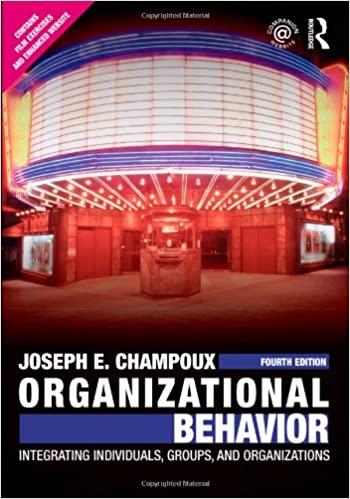Review the discussion of power at the beginning of this chapter. Does power serve positive or negative
Question:
Review the discussion of power at the beginning of this chapter. Does power serve positive or negative functions for an organization? Discuss your experiences with power.
POWER
Power is a person’s ability to get something done the way he wants it done. Power lets a person affect other people’s behavior, get people to do what they otherwise might not do, overcome resistance to changing direction, and overcome opposition. Someone with power also can prevent controversial issues from surfacing, especially during decision-making processes. Power includes the ability to gather and use physical and human resources to reach the person’s goals. Although power has a negative meaning for many people, it can have positive effects in organizations.
Power is essential to the functions of leadership and management. More than simply dominance, power is the capacity to get things done in an organization. Powerful managers and leaders can achieve more, get more resources for their subordinates, and give their subordinates more chances to develop and grow. Power is also a necessary part of controlling your fate and building self-esteem.
Power in organizations has the distinct facets of potential power, actual power, and the potential for power. Potential power exists when one party perceives another party as having power and the ability to use it. Actual power is the presence and use of power. The use of power may or may not successfully reach desired results. Use of power, whether successful or unsuccessful, is actual power. Potential for power is the chance that individuals or groups have to build a power base with resources they control. The facets of power imply a perceptual basis of power. Power exists when one party perceives that another party has potential power, actual power, or the ability to build a power base.
A power relationship is a moment of social interaction where power shows itself in organizations. Three dimensions define power relationships. The relational dimension is the social interaction part of power. Power in organizations happens during social interactions between people and groups. The dependence dimension views power as how much one party relies on the actions of another. Dependence is high when valued results are unavailable from another source. High power follows from high dependence. The sanctioning dimension refers to one party’s ability to affect the results of the other party by using rewards, penalties, or both. This power dimension has both actual and potential aspects. Actual sanctioning arises because of observations of sanctioning behavior. Potential sanctioning arises from expected sanctions or from the person’s reputation for using sanctions.
Power and authority are different concepts, although a person can have both power and authority.
Authority is the right to make decisions and to give direction to other people in an organization. Such authority comes to a person because of his position in the organization. It often is formally recognized in writing so people know their authority relationships. Look back at the definition of power given earlier. That definition associated power with a person’s ability to get things done, not with the person’s position in an organization. A person with power can be at any level in an organization, not just at the senior levels.
Power flows in all directions in organizations. It flows along the vertical dimension of organizations within superior–subordinate relationships. Power can also flow upward within superior–subordinate relationships. Here the subordinate influences his superior, a process some call “managing the boss.” The third direction of power is lateral. Managers usually are highly dependent on others at the same level for cooperation and resources. A manager needs to influence people and groups outside his direct reporting relationships. Such influence extends to people and groups in other departments, in other work units, and outside the organization.
Power is dynamic, not static. As the organization’s external environment changes, different subsystems of the organization, different individuals, and different coalitions may emerge as seats of power. Individuals, departments, and work units that are powerful at one point in the organization’s history may not be powerful at another point. For example, individuals and units responsible for marketing a successful new product are likely to develop power, but, if the product’s market share drops, their power will likely subside.
Step by Step Answer:

Organizational Behavior Integrating Individuals Groups And Organizations
ISBN: 9780415804646
4th Edition
Authors: Joseph E. Champoux





